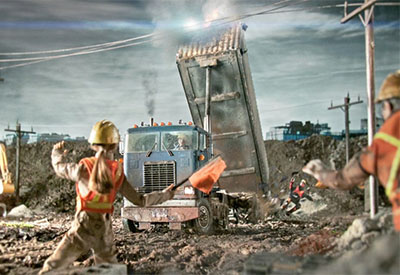Powerline Contact Continues to Be Unforgiving – Powerline Safety Week Starts May 13 with Ontario-wide Education Campaign

May 13, 2019
The invisible impact of powerlines should never be underestimated. In the past decade alone, 19 people in Ontario have lost their lives from overhead powerline contact. May 13 to 19 is Powerline Safety Week, which is meant to inform people across the province to stay vigilant of powerlines when doing work at home or on the job.
“Our work in raising awareness of powerline safety won’t be finished until there are zero injuries or lives lost from contact,” says Dr. Joel Moody, Chief Public Safety Officer, Electrical Safety Authority (ESA). “All it takes is a misstep or careless error to change the life of you, your colleagues or family.”
There have been 1,248 reported overhead powerline contacts in Ontario in the last ten years. Construction workers are at an especially high risk. Sixty per cent of powerline contacts have occurred on construction sites with dump trucks, the leading cause of contact. But accidents can happen easily at home too, even without powerline contact.
“Electricity can jump and activate areas up to 10 metres away from the source,” adds Moody. “Although simple work and yard tasks may seem danger-free, we encourage Ontarians to always look up and look out for overhead wires before beginning a project.”
ESA’s 2019 Powerline Safety Week campaign includes compelling digital and television advertising targeting both construction workers and homeowners; life-saving tips at esasafe.com/powerlinesafety; social media content aimed at educating Ontarians on the risks associated with powerlines; and partnerships with local electric utilities to help spread the powerline safety message.
5 Tips to #RespectThePower at Home:
- Locate the wires. Before starting any outdoor job, first look up, look out and locate the powerlines. Then keep track of where they are as you move around your yard.
- Stay back three metres from all powerlines – that means you as well as any tools such as ladders or pruners. Coming too close to the wires can cause electricity to jump or “arc” to you or your tools.
- Never attach, drape or brace anything on a powerline. And never grab a line for balance when working at heights.
- Carry ladders, pruners and other long equipment horizontally, not vertically. This helps you avoid, touching or attract arcing from an overhead line as you move around your yard.
- Plant trees away from overhead powerlines and call Ontario One Call before you dig to ensure underground cables and other utility-owned equipment are located and marked. If existing trees have grown into or close to powerlines, contact a trained utility arborist or your local electric utility to have the tree safely trimmed.
5 Tips to #RespectThePower at Work:
- Look up, look out! Identify all powerlines on site and make sure people and equipment stay at least three metres away to prevent an incident. Electricity can jump to you or your equipment if you’re too close to a powerline.
- Drivers of dump trucks and other high-reach vehicles must get a signaller to ensure equipment doesn’t come within three metres of overhead powerlines. This is outlined in the Occupational Health and Safety Act.
- Ensure that dump trucks on site drop their box after dumping the load. It’s good practice to have a raised box indicator installed in the truck to remind the driver the box is raised.
- Stay alert! Many incidents happen at the end of the day when workers are tired or rushing to finish a job.
- If wires fall down on the truck or the ground, always assume they are still energized. Stay in the vehicle, call 911 and keep everyone back at least 10 metres – the length of a school bus. Only the local utility worker on-site can confirm when the power is off and tell you when it’s safe to exit the vehicle.

















